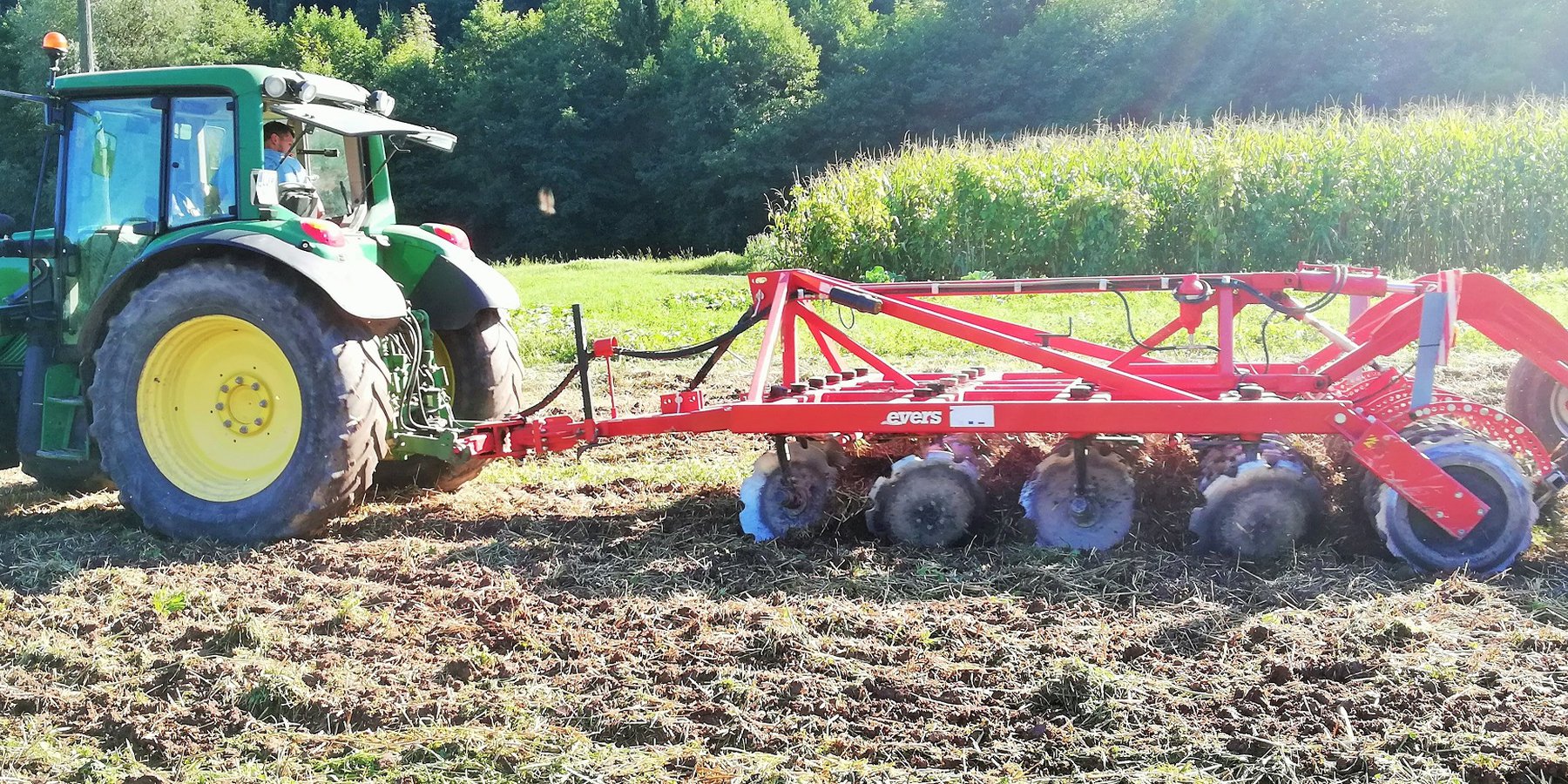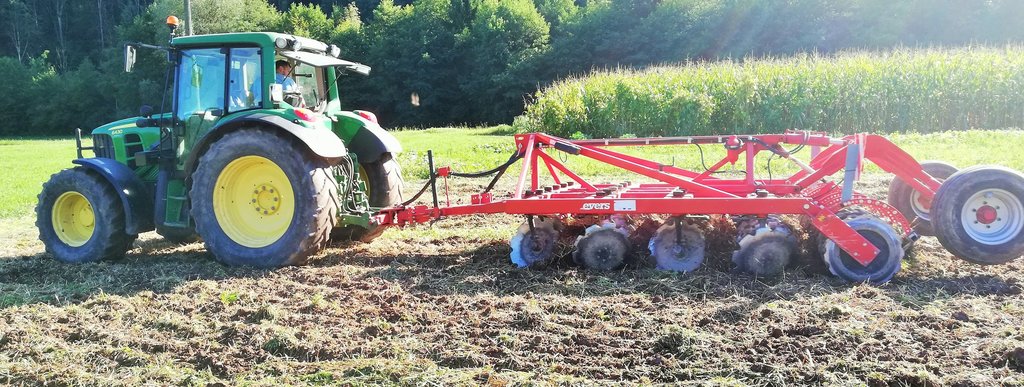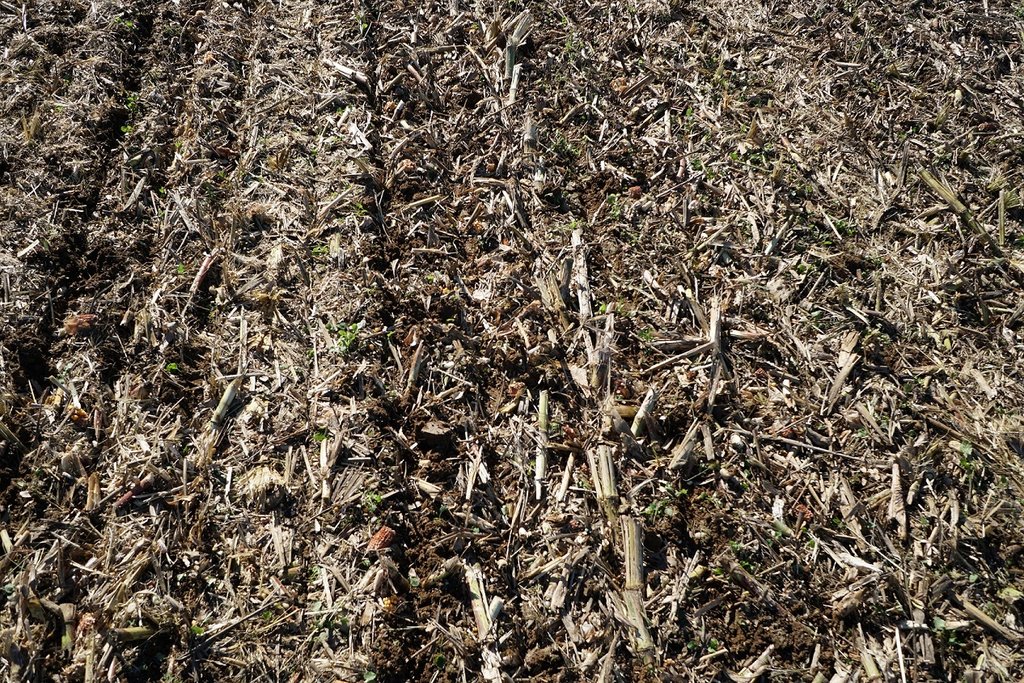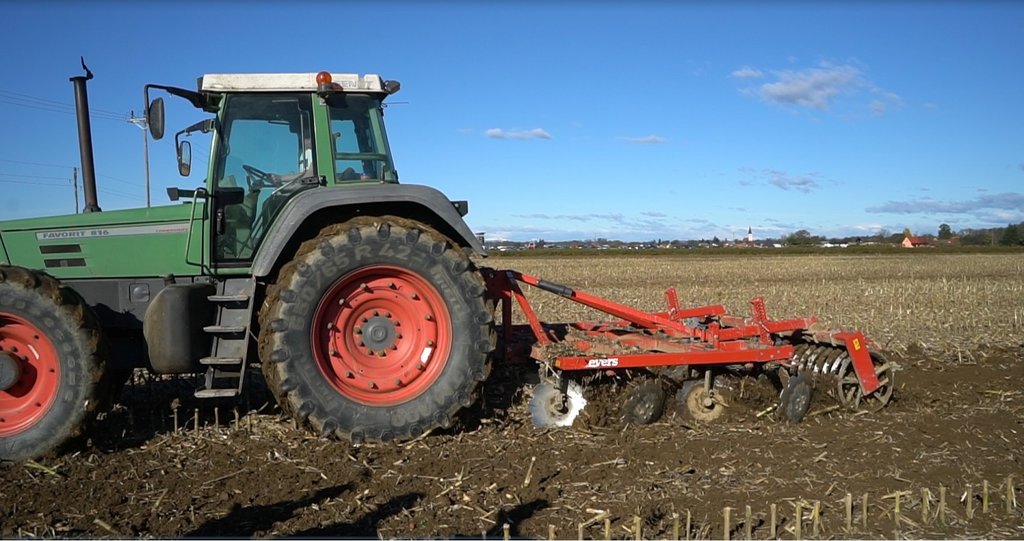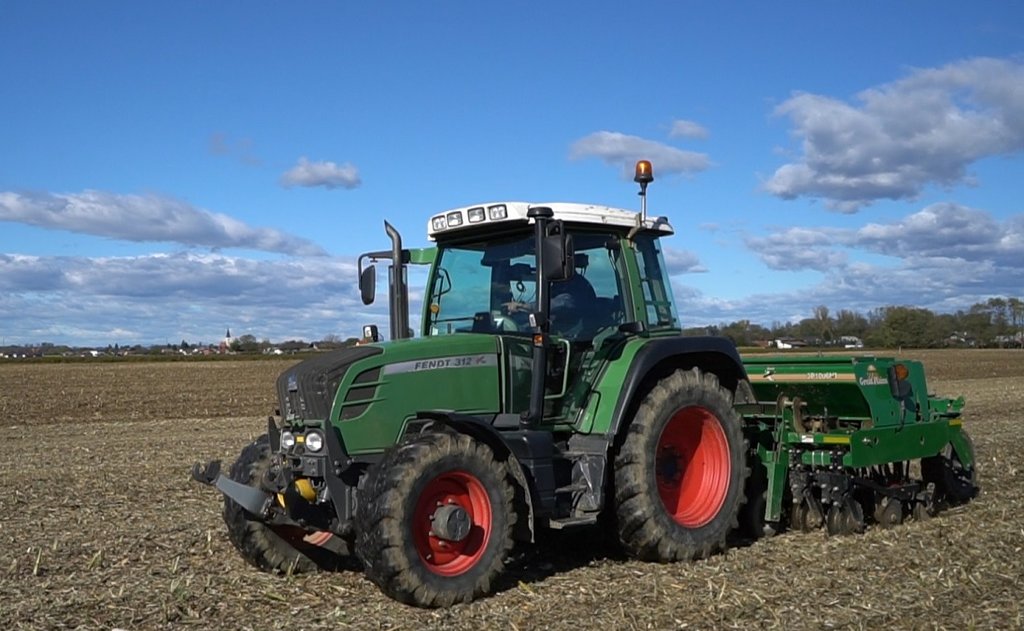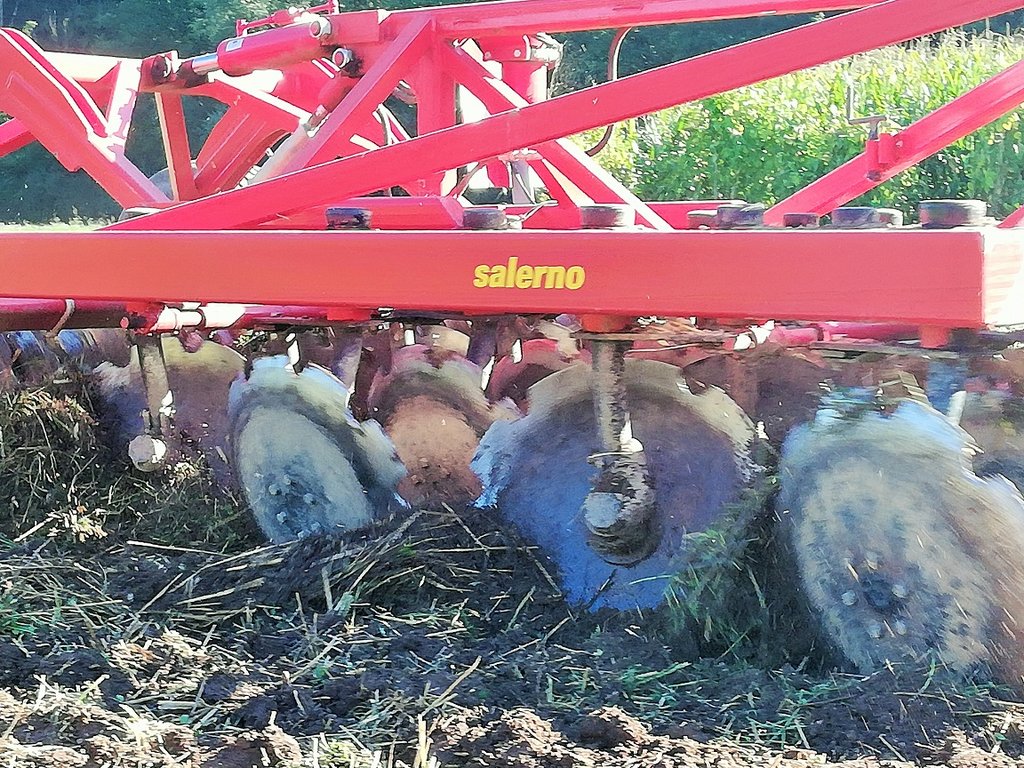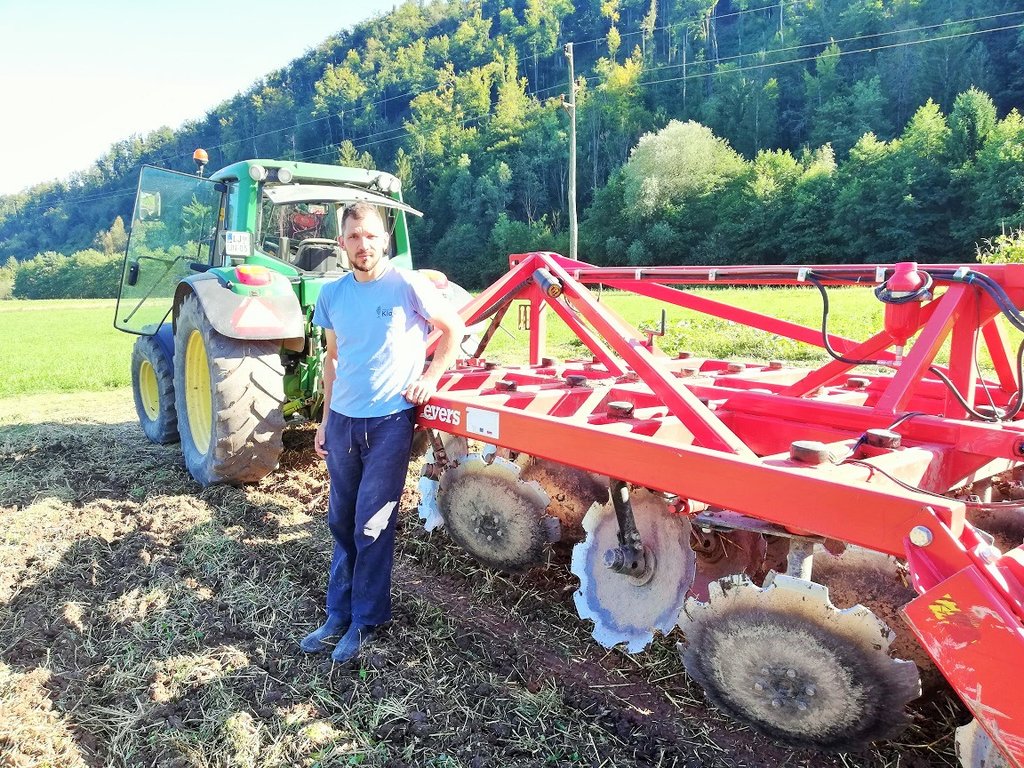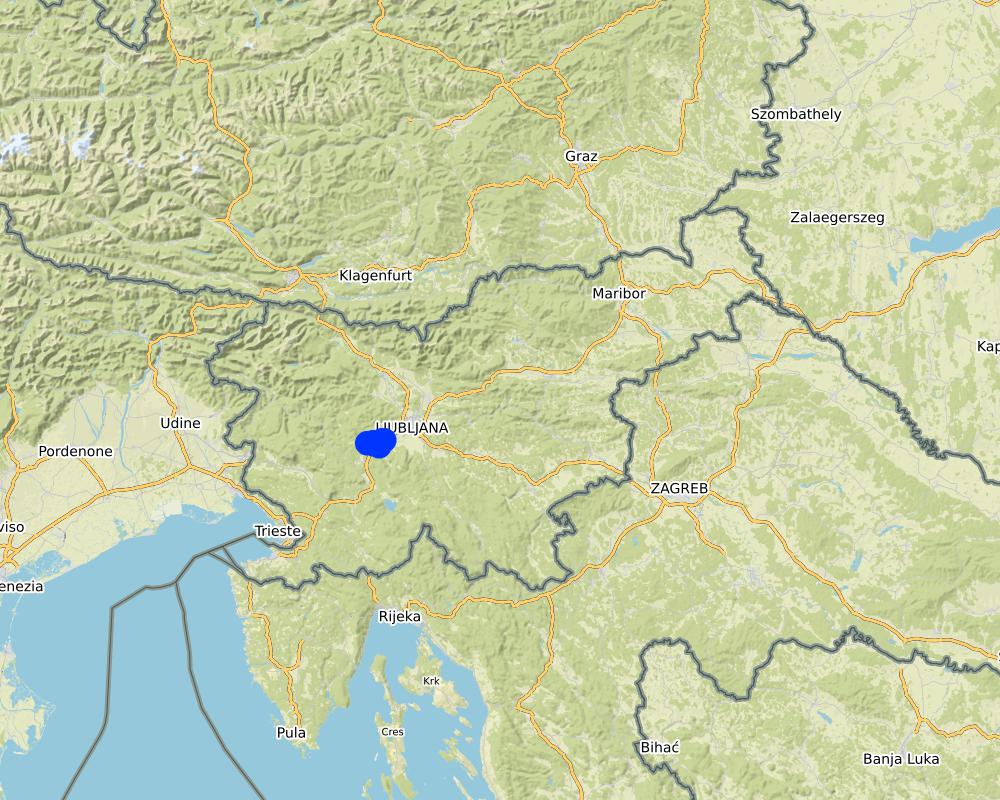Conservation tillage with incorporated mulched plant residues (mulch-till) [ສະໂນວາເນຍ]
- ການສ້າງ:
- ປັບປູງ:
- ຜູ້ສັງລວມຂໍ້ມູນ: Matjaz Glavan
- ບັນນາທິການ: –
- ຜູ້ທົບທວນຄືນ: Rima Mekdaschi Studer
Ohranitvena obdelava tal z vdelavo mulčenih rastlinskih ostankov
technologies_5494 - ສະໂນວາເນຍ
ເບິ່ງພາກສ່ວນ
ຂະຫຍາຍທັງໝົດ ຍຸບທັງໝົດ1. ຂໍ້ມູນທົ່ວໄປ
1.2 ຂໍ້ມູນ ການຕິດຕໍ່ພົວພັນ ຂອງບຸກຄົນທີ່ສໍາຄັນ ແລະ ສະຖາບັນ ທີ່ມີສ່ວນຮ່ວມ ໃນການປະເມີນເອກກະສານ ເຕັກໂນໂລຢີ
ບັນດາຜູ້ຕອບແບບສອບຖາມທີ່ສໍາຄັນ ()
ຜູ້ນໍາໃຊ້ທີ່ດິນ:
Mrzlikar Anton
Family farm
ສະໂນວາເນຍ
ຊື່ໂຄງການ ທີ່ອໍານວຍຄວາມສະດວກ ໃນການສ້າງເອກກະສານ/ປະເມີນ ເຕັກໂນໂລຢີ (ຖ້າກ່ຽວຂ້ອງ)
Interactive Soil Quality assessment in Europe and China for Agricultural productivity and Environmental Resilience (EU-iSQAPER)ຊື່ສະຖາບັນ (ຫຼາຍສະຖາບັນ) ທີ່ອໍານວຍຄວາມສະດວກ ໃນການສ້າງເອກກະສານ / ປະເມີນ ເຕັກໂນໂລຢີ (ຖ້າກ່ຽວຂ້ອງ)
Department for Agronomy, University of Ljubljana - ສະໂນວາເນຍ1.3 ເງື່ອນໄຂ ກ່ຽວກັບ ການນໍາໃຊ້ຂໍ້ມູນເອກະສານ ທີ່ສ້າງຂື້ນ ໂດຍຜ່ານ ອົງການພາບລວມຂອງໂລກ ທາງດ້ານແນວທາງ ແລະ ເຕັກໂນໂລຢີ ຂອງການອານຸລັກ ທໍາມະຊາດ (WOCAT)
ຜູ້ປ້ອນຂໍ້ມູນ ແລະ ບຸກຄົນສຳຄັນ ທີ່ໃຫ້ຂໍ້ມູນ (ຫຼາຍ) ຍິນຍອມ ຕາມເງື່ອນໄຂ ໃນການນຳໃຊ້ຂໍ້ມູນ ເພື່ອສ້າງເປັນເອກກະສານຂອງ WOCAT:
ແມ່ນ
1.4 ແຈ້ງການວ່າ ດ້ວຍຄວາມຍືນຍົງຂອງ ເຕັກໂນໂລຢີ
ການນໍາໃຊ້ ເຕັກໂນໂລຢີ ດັ່ງກ່າວໄດ້ອະທິບາຍ ເຖິງບັນຫາ ກ່ຽວກັບ ການເຊື່ອມໂຊມຂອງດິນບໍ? ຖ້າບໍ່ດັ່ງນັ້ນ ມັນບໍ່ສາມາດ ຢັ້ງຢືນໄດ້ວ່າ ເປັນເຕັກໂນໂລຊີ ໃນການຄຸ້ມຄອງ ທີ່ດິນແບບຍືນຍົງ? :
ບໍ່ແມ່ນ
2. ການອະທິບາຍ ເຕັກໂນໂລຢີ ຂອງການຄຸ້ມຄອງ ທີ່ດິນແບບຍືນຍົງ
2.1 ຄໍາອະທິບາຍສັ້ນຂອງ ເຕັກໂນໂລຢີ
ການກຳໜົດຄວາມໝາຍ ຂອງເຕັກໂນໂລຢີ:
Conservation tillage with incorporated mulched plant residues (mulch-till) of harvested crop or a green manure that are part of the rotation). Crop residues are partially incorporated/mixed in topsoil layer (down to 10 cm) using a disc harrow, chisel plough, sweeps, field cultivators, that leave more than 30% of the soil surface covered with crop residue. Technology contributes to less soil disturbance, increase of soil organic matter, better soil structure and better water holding capacity of soils.
2.2 ການອະທິບາຍ ລາຍລະອຽດ ຂອງເຕັກໂນໂລຢີ
ການພັນລະນາ:
1. The technology of conservational tillage with incorporated mulched plant residues (mulch-till) is applied in flatlands around the Municipality of Vrhnika with an average altitude of 290 m.a.s.l. Average annual precipitation is 1400 mm. The area is characterized with often stormy precipitation events and occasional summer droughts. A farmer applies this technology on various soil types from silty loam to silty clay Gleysol to organic Histosol soils (peat). Soils in the area are generally moderately deep to deep with medium soil organic matter (Gleysol) of 3-7% or with a high share of organic matter (Histosol) of >20% (Ljubljana moors). The area has good availability of surface water and groundwater of good drinking quality. Gleysol areas are drained (drainage systems) to prevent floods to enable cultivation. Histosol areas are drained (open-channel drainage systems) to enable arable crop production. However, due to high groundwater and many surface water sources, certain areas are regularly flooded during flood events mostly in late autumn, winter and spring. Salinity is not a problem due to high precipitation and leaching. Farmer practices rotational agriculture. Less than 5% of income coming from off-farm activities. The examined farm household has an average wealth and is fully mechanized/motorized. the farm has good access to services and infrastructure. The examined farm is medium in scale with land partly owned by the land user and partly leased from other private owners.The general biodiversity of the area is medium on Gleysols to high on Histosol where nature protection Landscape Park of Ljubljansko Barje (The Ljubljana Moors Landscape Park) is located.
Part of the farmers land parcels is located inside boundaries of Krajinski park Ljubljansko barje /Ljubljana Moor Landscape park. Park takes a lot of actions to secure peat soils. This almost 16,000 hectares large lowland marshy plain is marked by an interminable mosaic of grasslands, broadleaf woodlands, fields, ditches and hedges.
The farmer decided to abandon conventional ploughing technology and to start with conservational tillage technology when he noticed that the organic layer of peat soils in these areas started to become thinner. Farmer introduced this technology to preserve peat soils of Ljubljana Moors on his parcels in 2015. With ploughing, peat was mixed and decomposing - mineralise. In 18th-century peat layers of up to 2m depth were exploited for the same use as firewood. Only shallow layers of peat soil (up to 1 m) are still covering agricultural areas. As peat is a source of fertility farmers are seeking ways of preserving it. Farmer Anton Mrzlikar took a lead and started with conservational tillage with incorporated mulched plant residues (mulch-till).
Video https://vimeo.com/97415985 presents the effects of conservational tillage with incorporated mulched plant residues (mulch-till) on soil stability. This is a simulation of abundant summer rain and its impact on the tilled soils in terms of water infiltration capacity and erodibility. The result of this simulation is presented very clearly. It shows the difference between long-term conventional versus conservation tillage (mulch-till). Conventional tillage ploughs the top 25-28 cm of the soil at least once or twice a year. The soil is inverted, its structure breaks down and the surface is left bare. The first raindrops break the structural aggregates causing soil surface siltation and blockage of the soil pores. Thus vertical water flow is blocked and redirected as surface runoff, causing distinct erosion. If fertilizers and pesticides are used, the water flow will transport them, along with the soil particles, to surface waters where they cause pollution or surface ponding on the fields. This leads to an uneven distribution of substances across the field surface.
In conservation tillage (mulch-till), a shallow, 10 cm layer of topsoil is mixed with organic residues which are thus retained near and on the surface. In this way, soil structure is reinforced with good soil water infiltration and absorption. Despite heavy rainfall, the soils do not show any signs of erosion. There is no surface flow. Water drains into the soil vertical flow where it is available to the plants.
2. The farmer usees of 4-row-disk harrow tillage machinery (vario-disc) on arable fields for all crop types. When cultivating fields he crosses fields 1 - 2 times (depends on soil moisture). Every few years he uses chisels to break and shatters (aerate) the soils (depends on crop type - cereals and drought years). After main/first crop he seeds various cover crops (if fodder is needed they harvested it otherwise is used for green manure). He uses manure 30-40 t/ha. He applies typical dairy cow farm rotation (cereals/maize/soya/grass-clover mix). Cover crops are classified as rapes, cereals, oats, grass-clover, grass.
3. The main function is an increase of organic matter, retain water, increase soil biodiversity, stabilise soil structure in the soils and reduce water erosion, as well as reduce energy consumption and costs. This leads to better (1) productivity due to nutrients slow-release, (2) better water holding capacity and (3) decreased soil compaction threat. The technology was introduced to prevent decomposition of organic matter on Ljubljana moor peat soils.
4. Major inputs needed to establish is to change machinery and to gain new knowledge and experiences. They had to buy 4-row disc harrows, chisels plough and new seeders (maize). Seeding machines for cereals and oilseed rape are hired from other farmers. It is important that soils are covered all year round. Soils must be dry when cultivated.
5. The benefits are (1) increase in soil organic matter, (2) increase soil water holding capacity, (3) to maintain soil productivity, (4) increase in yields quantity and quality, (5) reduce energy consumption, (6) reduce workload - 3-4 times less time used for cultivation, (7) reduce costs.
6. Land users like (1) reduced workload and energy consumption, (2) positive impact on soil fertility and stability, (3) preserves organic matter - decrease peat soils decomposition, (4) as soils need to be covered all the time they produce more feed for cows, (5) smooths surface fields, (6) with disc harrow is easy to till soils even when residues are present on fields, (7) less soil compaction
Land users dislike: (1) investment cost for new machinery are high, (2) time to change in doing things and practice, (3) on clay soils (Gleysol) surface ponding is occurring, (4) soils need to be drier for tilling in comparison to ploughing.
2.3 ຮູບພາບຂອງເຕັກໂນໂລຢີ
2.4 ວິດີໂອ ເຕັກໂນໂລຢີ
ຄວາມຄິດເຫັນ, ຄໍາອະທິບາຍຫຍໍ້:
This is a simulation of abundant summer rain and its impact on the tilled soils in terms of water infiltration capacity and erodibility. The result of this simulation is presented very clearly. It shows the difference between long-term conventional versus conservation soil tillage.
Conventional tillage ploughs the top 25-28 cm of the soil at least once or twice a year. The soil is inverted, its structure breaks down and the surface is left bare. The first raindrops break the structural aggregates causing soil surface siltation and blockage of the soil pores. Thus vertical water flow is blocked and redirected as surface runoff, causing distinct erosion. If fertilizers and pesticides are used, the water flow will transport them, along with the soil particles, to surface waters where they cause pollution or surface ponding on the fields. This leads to an uneven distribution of substances across the field surface.
In conservation tillage (mulch-till), a shallow, 10 cm layer of topsoil is mixed with organic residues which are thus retained near and on the surface. In this way, soil structure is reinforced with good soil water infiltration and absorption. Despite heavy rainfall, the soils do not show any signs of erosion. There is no surface flow. Water drains into the soil vertical flow where it is available to the plants.
ວັນທີ:
04/12/2017
ສະຖານທີ່:
Ljubljana, Biotechnical Faculty, University of LJubljana
ຊື່ຂອງຜູ້ຖ່າຍວີດີໂອ:
Rok Mihelič, Marko Zupan, Matjaž Glavan - Agronomy Department, Biotechnical Faculty, University of Ljubljana
ຄວາມຄິດເຫັນ, ຄໍາອະທິບາຍຫຍໍ້:
Presenting 4-row disch harrow in action.
ວັນທີ:
12/04/2017
ສະຖານທີ່:
Slovenia
ຊື່ຂອງຜູ້ຖ່າຍວີດີໂອ:
Rok Mihelič, Agronomy Department, Biotechnical Faculty, University of Ljubljana
ຄວາມຄິດເຫັນ, ຄໍາອະທິບາຍຫຍໍ້:
Presening seeder (cereals/oilseed rape) in action and condition of soil surface after tillage and seeding.
ວັນທີ:
12/04/2017
ສະຖານທີ່:
Slovenia
ຊື່ຂອງຜູ້ຖ່າຍວີດີໂອ:
Rok Mihelič, Agronomy Department, Biotechnical Faculty, University of Ljubljana
2.5 ປະເທດ / ເຂດ / ສະຖານທີ່ບ່ອນທີ່ ເຕັກໂນໂລຢີ ໄດ້ຮັບການນໍາໃຊ້ ແລະ ທີ່ຖືກປົກຄຸມດ້ວຍການປະເມີນຜົນ
ປະເທດ:
ສະໂນວາເນຍ
ພາກພື້ນ / ລັດ / ແຂວງ:
Central Slovenia
ຂໍ້ມູນເພີ່ມເຕີມຂອງສະຖານທີ່:
Podlipa, Vrhnika. This specific farmer applies this technology on Ljubljansko barje, othewise is applied all over Slovenia
ໃຫ້ລະບຸ ການແຜ່ຂະຫຍາຍ ເຕັກໂນໂລຢີ:
- ນໍາໃຊ້ໃນຈຸດສະເພາະ / ແນໃສ່ນໍາໃຊ້ໃນພື້ນທີ່ຂະໜາດນ້ອຍ
ສ່ວນຫຼາຍສະຖານທີ່ຕັ້ງຂອງເຕັກໂນໂລຢີ ແມ່ນ ຢູ່ໃນເຂດພື້ນທີ່ສະຫງວນບໍ?
ແມ່ນ
ຖ້າແມ່ນ, ໃຫ້ລະບຸແຈ້ງ:
Part of his land parcels is located inside boundaries of Krajinski park Ljubljansko barje /Ljubljana Moor Landscape park. Park takes a lot of actions to secure peat soils. This almost 16,000 hectares large marshy plain is marked by an interminable mosaic of grasslands, broadleaf woodlands, fields, ditches and hedges.
http://www.ljubljanskobarje.si/?lang=en
Map
×2.6 ວັນທີໃນການຈັດຕັ້ງປະຕິບັດ
ໃຫ້ລະບຸປີ ໃນການຈັດຕັ້ງປະຕິບັດ:
2015
ຖ້າຫາກວ່າ ບໍ່ຮູ້ຈັກ ປີທີ່ຊັດເຈນ ແມ່ນໃຫ້ປະມານ ວັນທີເອົາ:
- ຕໍ່າກວ່າ 10 ປີ ຜ່ານມາ (ມາເຖິງປະຈຸບັນ)
2.7 ການນໍາສະເໜີ ເຕັກໂນໂລຢີ
ໃຫ້ລະບຸ ເຕັກໂນໂລຢີ ໄດ້ຖືກຈັດຕັ້ງປະຕິບັດຄືແນວໃດ?
- ໂດຍຜ່ານນະວັດຕະກໍາຄິດຄົ້ນຂອງຜູ້ນໍາໃຊ້ທີ່ດິນ
ຄວາມຄິດເຫັນ (ປະເພດ ໂຄງການ ແລະ ອື່ນໆ):
Farmer introduced this technology to preserve peat soils of Ljubljana Moors on his parcels in 2015. With ploughing, peat was mixed and decomposing - mineralise. In 18th-century peat layers of up to 2m depth were exploited for the same use as firewood. Only shallow layers of peat soil (up to 1 m) are still covering agricultural areas. As peat is a source of fertility farmers are seeking ways of preserving it. Farmer Anton Mrzlikar took a lead and started with mulch-till.
3. ການໃຈ້ແຍກ ເຕັກໂນໂລຢີ ໃນການຄຸ້ມຄອງ ດິນແບບຍືນຍົງ
3.1 ຈຸດປະສົງຫຼັກ (ຫຼາຍ) ຂອງເຕັກໂນໂລຢີ
- ຫຼຸດຜ່ອນ, ປ້ອງກັນ, ຟື້ນຟູ ການເຊື່ອມໂຊມຂອງດິນ
- ປັບຕົວຕໍ່ກັບການປ່ຽນແປງດິນຟ້າອາກາດ / ທີ່ຮ້າຍແຮງ ແລະ ຜົນກະທົບ
- ສ້າງຜົນກະທົບ ທາງເສດຖະກິດ ທີ່ເປັນປະໂຫຍດ
3.2 ປະເພດການນໍາໃຊ້ທີ່ດິນ ໃນປະຈຸບັນ() ທີ່ເຕັກໂນໂລຢີ ໄດ້ຖືກນໍາໃຊ້
ການນຳໃຊ້ທີ່ດິນ ປະສົມພາຍໃນພື້ນທີ່ດຽວກັນ:
ບໍ່ແມ່ນ

ດິນທີ່ປູກພືດ
- ການປູກພືດປະຈໍາປີ
ການປູກພືດປະຈຳປີ - ລະບຸປະເພດພືດ:
- ທັນຍາພືດ-ສາລີ
- cereals - maize - legumes - grass-clover mix
ລະບົບການປູກພືດປະຈຳປີ:
ສາລີ ຫຼື ພືດຫມູນວຽນຄ້າຍຄືກັນກັບ ຫຍ້າ / ທົ່ງຫຍ້າລ້ຽງສັດ
ຈໍານວນ ລະດູການ ປູກໃນປີໜຶ່ງ:
- 1
ມີການເຝືກປູກພືດແບບສັບຫວ່າງບໍ່?
ບໍ່ແມ່ນ
ມີການເຝືກປູກພືດແບບໝູນວຽນບໍ່?
ແມ່ນ
ຖ້າແມ່ນ, ໃຫ້ລະບຸແຈ້ງ:
cereals/maize/soy/grass-clover mix, additionally cover crops after main crop (soil must be covered all year round
3.3 ການນຳໃຊ້ທີ່ດິນ ມີການປ່ຽນແປງຍ້ອນການຈັດຕັ້ງທົດລອງເຕັກໂນໂລຢີ ແມ່ນບໍ່?
ການນຳໃຊ້ທີ່ດິນ ມີການປ່ຽນແປງຍ້ອນການຈັດຕັ້ງທົດລອງເຕັກໂນໂລຢີ ແມ່ນບໍ່?
- ບໍ່ (ຕໍ່ເໜືອງກັບ ຄຳຖາມ 3.4)
3.4 ການສະໜອງນ້ຳ
ການສະໜອງນໍ້າ ໃນພື້ນທີ່ ທີ່ໄດ້ນໍາໃຊ້ ເຕັກໂນໂລຢີ:
- ນໍ້າຝົນ
3.5 ການນໍາໃຊ້ເຕັກໂນໂລຢີ ທີ່ຢູ່ໃນກຸ່ມການຄຸ້ມຄອງ ທີ່ດິນແບບຍືນຍົງ
- ການຫຼຸດຜ່ອນ ກິດຈະກໍາ ທີ່ລົບກວນດິນ
3.6 ມາດຕະການ ການຄຸ້ມຄອງ ທີ່ດິນແບບຍືນຍົງ ປະກອບດ້ວຍ ເຕັກໂນໂລຢີ

ມາດຕະການ ທາງການກະສິກໍາ
- A2: ອິນຊີວັດຖຸ ຫຼື ຄວາມອຸດົມສົມບູນໃນດິນ
- A3: ການບໍາລຸງຮັກສາຊັ້ນໜ້າດິນ
A3: ລະບົບການໄຖແຕກຕ່າງກັນ:
A 3.2: Reduced tillage (> 30% soil cover)
3.7 ປະເພດດິນເຊື່ອມໂຊມ ຫຼັກທີ່ໄດ້ນໍາໃຊ້ ເຕັກໂນໂລຢີ

ດິນເຊາະເຈື່ອນ ໂດຍນໍ້າ
- Wt: ການສູນເສຍຊັ້ນໜ້າດິນ / ການເຊາະເຈື່ອນຜິວໜ້າດິນ

ການເຊື່ອມໂຊມ ຂອງດິນ ທາງກາຍະພາບ
- Pc: ການອັດແໜ້ນ
- Ps: ຊຸດຂອງດິນອົງຄະທາດ, ການຕັ້ງຖິ່ນຖານຂອງດິນ
3.8 ການປ້ອງກັນ, ການຫຼຸດຜ່ອນ, ຫຼືການຟື້ນຟູຂອງການເຊື່ອມໂຊມຂອງດິນ
ໃຫ້ລະບຸ ເປົ້າໝາຍ ເຕັກໂນໂລຢີ ທີ່ພົວພັນ ກັບຄວາມເຊື່ອມໂຊມຂອງດິນ:
- ຫຼຸດຜ່ອນການເຊື່ອມໂຊມຂອງດິນ
ຄວາມຄິດເຫັນ:
It is impossible to prevent degradation in the form of peat soil mineralisation in agricultural soils.
4. ຂໍ້ກໍາໜົດ, ກິດຈະກໍາການປະຕິບັດ, ວັດຖຸດິບ, ແລະຄ່າໃຊ້ຈ່າຍ
4.1 ເຕັກນິກ ໃນການແຕ້ມແຜນວາດ ເຕັກໂນໂລຢີ
4.2 ຂໍ້ມູນທົ່ວໄປກ່ຽວກັບການຄິດໄລ່ປັດໃຈຂາເຂົ້າໃນການຜະລິດ ແລະ ມູນຄ່າອື່ນໆ
ລະບຸ ວິທີການ ຄຳໃຊ້ຈ່າຍ ແລະ ປັດໄຈນໍາເຂົ້າ ທີ່ໄດ້ຄິດໄລ່:
- ຕໍ່ພື້ນທີ່ ທີ່ໄດ້ຈັດຕັ້ງປະຕິບັດ ເຕັກໂນໂລຢີ
ໃຫ້ລະບຸຫົວໜ່ວຍ ຂະໜາດ ແລະ ເນື້ອທີ່:
30 ha
ສະກຸນເງິນອື່ນໆ / ປະເທດອື່ນໆ (ລະບຸ):
EUR
ຖ້າກ່ຽວຂ້ອງ, ໃຫ້ລະບຸອັດຕາແລກປ່ຽນຈາກ USD ເປັນສະກຸນເງິນທ້ອງຖິ່ນ (ເຊັ່ນ: 1 USD = 79.9 Brazilian Real): 1 USD =:
0.9
ລະບຸ ຄ່າຈ້າງ ຄ່າແຮງງານສະເລ່ຍ ຕໍ່ ວັນ:
50 EUR
4.3 ການສ້າງຕັ້ງກິດຈະກໍາ
| ກິດຈະກໍາ | Timing (season) | |
|---|---|---|
| 1. | Preparation of fields: Leveling depressions, reconstruction of drainage channels, using chisels to loose, break and aerate soil in deeper layers | two year before implemenation, dry soil. |
| 2. | Purchase of 4-row disc harrow | 1st year |
| 3. | Purchase of seeder for maize | 1st year |
| 4. | Purchase of seeder for cover crops | 1st year |
| 5. | Hire seeder for cereals (wheat, barley) | 1st year |
| 6. | Home made chisel plow for loosening the soil | 2nd year |
| 7. | Purchase of spraying machine | 3rd year |
| 8. | Purchase of GPS navigation system | 3rd year |
ຄວາມຄິດເຫັນ:
The agricultural technology activities are listed in chronological order. Rotation cycle takes 3 years
4.4 ຕົ້ນທຶນ ແລະ ປັດໄຈຂາເຂົ້າທີ່ຈໍາເປັນໃນຈັດຕັ້ງປະຕິບັດ
| ລະບຸ ປັດໃຈ ນໍາເຂົ້າ ໃນການຜະລີດ | ຫົວໜ່ວຍ | ປະລິມານ | ຕົ້ນທຶນ ຕໍ່ຫົວໜ່ວຍ | ຕົ້ນທຶນທັງໝົດ ຂອງປັດໃຈຂາເຂົ້າ ໃນການຜະລິດ | % ຂອງຕົ້ນທຶນທັງໝົດ ທີ່ຜູ້ນໍາໃຊ້ທີ່ດິນ ໃຊ້ຈ່າຍເອງ | |
|---|---|---|---|---|---|---|
| ອຸປະກອນ | chisel plow material (home made) | EUR/piece | 1.0 | 6500.0 | 6500.0 | 100.0 |
| ອຸປະກອນ | seeder fo cover crops | EUR/piece | 1.0 | 2500.0 | 2500.0 | 50.0 |
| ອຸປະກອນ | seeder for maize | EUR/piece | 1.0 | 7500.0 | 7500.0 | 50.0 |
| ອຸປະກອນ | 4-row disk harrow | EUR/piece | 1.0 | 23000.0 | 23000.0 | 50.0 |
| ອຸປະກອນ | sprayer | EUR/piece | 1.0 | 12.5 | 12.5 | 25.0 |
| ອຸປະກອນ | GPS navigation | EUR/piece | 1.0 | 2500.0 | 2500.0 | 100.0 |
| ອຸປະກອນ | hire seeder for cereals | EUR/ha | 15.0 | 50.0 | 750.0 | 100.0 |
| ຕົ້ນທຶນທັງໝົດ ໃນການຈັດຕັ້ງປະຕິບັດ ເຕັກໂນໂລຢີ | 42762.5 | |||||
| ຄ່າໃຊ້ຈ່າຍທັງໝົດ ສຳລັບການສ້າງຕັ້ງເຕັກໂນໂລຢີ ເປັນສະກຸນເງີນໂດລາ | 47513.89 | |||||
ຖ້າຫາກຜູ້ນຳໃຊ້ທີ່ດິນ ນຳໃຊ້ມູນຄ່າຕ່ຳກວ່າ 100% ໃຫ້ລະບຸ ແມ່ນໃຜເປັນຜູ້ຊ່ວຍ ໃນລາຍຈ່າຍທີ່ເຫຼືອ:
50% - Agency for agricultural payments (EU funds); 25% - sharred among farmers
ຄວາມຄິດເຫັນ:
Cost for hiring seeder is calculated for 15ha as cereals cover 15ha of arable land.
4.5 ບໍາລຸງຮັກສາ / ແຜນຈັດຕັ້ງປະຕິບັດ ກິດຈະກໍາ
| ກິດຈະກໍາ | ໄລຍະເວລາ / ຄວາມຖີ່ | |
|---|---|---|
| 1. | Maintenance of 4-disc harrow | 6 time per year, before or after use of equipment |
| 2. | Maintenance of Spayer | before use nozzels check, after use cleaning |
| 3. | Maintenance of seeder for maize | before and after use |
| 4. | Maintenance of seeder for cover crops | before and after use |
4.6 ຄ່າໃຊ້ຈ່າຍ ແລະ ປັດໄຈນໍາເຂົ້າທີ່ຈໍາເປັນສໍາລັບການບໍາລຸງຮັກສາກິດຈະກໍາ / ແຜນປະຕິບັດ (ຕໍ່ປີ)
| ລະບຸ ປັດໃຈ ນໍາເຂົ້າ ໃນການຜະລີດ | ຫົວໜ່ວຍ | ປະລິມານ | ຕົ້ນທຶນ ຕໍ່ຫົວໜ່ວຍ | ຕົ້ນທຶນທັງໝົດ ຂອງປັດໃຈຂາເຂົ້າ ໃນການຜະລິດ | % ຂອງຕົ້ນທຶນທັງໝົດ ທີ່ຜູ້ນໍາໃຊ້ທີ່ດິນ ໃຊ້ຈ່າຍເອງ | |
|---|---|---|---|---|---|---|
| ແຮງງານ | Maintenance of 4-disc harrow | hour | 6.0 | 6.25 | 37.5 | 100.0 |
| ແຮງງານ | Maintenance of Spayer | hour | 6.0 | 6.25 | 37.5 | 100.0 |
| ແຮງງານ | Maintenance of seeder for maize | hour | 4.0 | 6.25 | 25.0 | 100.0 |
| ແຮງງານ | Maintenance of seeder for cover crops | hour | 1.0 | 6.25 | 6.25 | 100.0 |
| ອຸປະກອນ | Lubricant cartridge for4-disc harrow | cartridge | 18.0 | 5.0 | 90.0 | 100.0 |
| ອຸປະກອນ | Nozzels for Spayer | nozzel | 20.0 | 4.0 | 80.0 | 100.0 |
| ອຸປະກອນ | Lubricant cartridge for seeder for maize | cartridge | 4.0 | 5.0 | 20.0 | 100.0 |
| ອຸປະກອນ | Lubricant cartridge for seeder for cover crops | cartridge | 1.0 | 5.0 | 5.0 | 100.0 |
| ຕົ້ນທຶນທັງໝົດ ທີ່ໃຊ້ໃນການບໍາລຸງຮັກສາ ເຕັກໂນໂລຢີ | 301.25 | |||||
| ຄ່າໃຊ້ຈ່າຍທັງໝົດ ສຳລັບການບົວລະບັດຮກສາເຕັກໂນໂລຢີ ເປັນສະກຸນເງີນໂດລາ | 334.72 | |||||
ຄວາມຄິດເຫັນ:
There is a big difference between conventional and conservation tillage in time spend cultivating fields.
Farmer estimates reduction in workload (no ploughing) for 3-4 times in comparison to the conventional ploughing system.
Farmer points out an increase in green mass yield (clover, grass) due to cover crops which can be used as feed for livestock or green manure. He said that the most important part of this conservational system (mulch-till) is to prevent weeds to germinate, and that's why soil needs to be covered at all times.
He also states that top and subsoil layers are loose.
He states that he still uses the same amount of plant protection products.
The use of herbicides and fertilisers is at the same range as before the shift in practice, but he expects improvements in the future when he will further enhance knowledge on crop types, rotation and cover crops.
4.7 ປັດໄຈ ທີ່ສໍາຄັນ ທີ່ສົ່ງຜົນກະທົບ ຕໍ່ຄ່າໃຊ້ຈ່າຍ
ໃຫ້ອະທິບາຍ ປັດໃຈ ທີ່ສົ່ງຜົນກະທົບ ຕໍ່ຕົ້ນທຶນ ໃນການຈັດຕັ້ງປະຕິບັດ:
The starting cost - The type of machinery is needed that has to be robust and heavy to much-till and seed into the soil.
The machinery must be in use to return a profit. Working hours are reduced now (no ploughing). Machine operators with more competences can reduce costs.
5. ສະພາບແວດລ້ອມທໍາມະຊາດ ແລະ ມະນຸດ
5.1 ອາກາດ
ປະລິມານນໍ້າຝົນປະຈໍາປີ
- < 250 ມີລິແມັດ
- 251-500 ມີລິແມັດ
- 501-750 ມີລິແມັດ
- 751-1,000 ມີລິແມັດ
- 1,001-1,500 ມີລິແມັດ
- 1,501-2,000 ມີລິແມັດ
- 2,001-3,000 ມີລິແມັດ
- 3,001-4,000 ມີລິແມັດ
- > 4,000 ມີລິແມັດ
ເຂດສະພາບອາກາດກະສິກໍາ
- ຄວາມຊຸ່ມ
Heavy summer thunderstorms and showers. Local precipitation.
5.2 ພູມິປະເທດ
ຄ່າສະເລ່ຍ ຄວາມຄ້ອຍຊັນ:
- ພື້ນທີ່ຮາບພຽງ (0-2%)
- ອ່ອນ (3-5 %)
- ປານກາງ (6-10 %)
- ມ້ວນ (11-15 %)
- ເນີນ(16-30%)
- ໍຊັນ (31-60%)
- ຊັນຫຼາຍ (>60%)
ຮູບແບບຂອງດິນ:
- ພູພຽງ / ທົ່ງພຽງ
- ສັນພູ
- ເປີ້ນພູ
- ເນີນພູ
- ຕີນພູ
- ຮ່ອມພູ
ເຂດລະດັບສູງ:
- 0-100 ແມັດ a.s.l.
- 101-500 ແມັດ a.s.l.
- 501-1,000 ແມັດ a.s.l.
- 1,001-1,500 ແມັດ a.s.l.
- 1,501-2,000 ແມັດ a.s.l.
- 2,001-2,500 ແມັດ a.s.l.
- 2,501-3,000 ແມັດ a.s.l.
- 3,001-4,000 ແມັດ a.s.l.
- > 4,000 ແມັດ a.s.l.
ໃຫ້ລະບຸ ເຕັກໂນໂລຢີ ທີ່ໄດ້ຖືກນຳໃຊ້:
- ບໍ່ກ່ຽວຂ້ອງ
5.3 ດິນ
ຄວາມເລິກ ຂອງດິນສະເລ່ຍ:
- ຕື້ນຫຼາຍ (0-20 ຊັງຕີແມັດ)
- ຕື້ນ (21-50 ຊຕມ)
- ເລີກປານກາງ (51-80 ຊຕມ)
- ເລິກ (81-120 ຊມ)
- ເລິກຫຼາຍ (> 120 cm)
ເນື້ອດິນ (ໜ້າດິນ):
- ບາງລະອຽດ / ໜັກ (ໜຽວ)
ເນື້ອດິນ (ເລິກຈາກໜ້າດິນ ລົງໄປຫຼາຍກວ່າ 20 ຊັງຕິແມັດ):
- ບາງລະອຽດ / ໜັກ (ໜຽວ)
ຊັ້ນອິນຊີວັດຖຸ ເທິງໜ້າດິນ:
- ສູງ (> 3 %)
ຖ້າເປັນໄປໄດ້ ແມ່ນໃຫ້ຕິດຄັດ ການພັນລະນາດິນ ຫຼື ຂໍ້ມູນສະເພາະຂອງດິນ, ຕົວຢ່າງ, ຄຸນລັກສະນະ ປະເພດຂອງດິນ, ຄ່າຄວາມເປັນກົດ / ເປັນດ່າງຂອງດິນ, ສານອາຫານ, ດິນເຄັມ ແລະ ອື່ນໆ.
Organic matter on Gleysol is around 6% and on Histosol (peatland) more than 30%. Bellow the peatland is clay (called "polžarica", or "snail clay")
5.4 ມີນໍ້າ ແລະ ຄຸນນະພາບ
ລະດັບ ນໍ້າໃຕ້ດິນ:
< 5 ແມັດ
ການມີນໍ້າ ເທິງໜ້າດິນ:
ດີ
ຄຸນນະພາບນໍ້າ (ບໍ່ມີການບໍາບັດ):
ນຳໃຊ້ເຂົ້າໃນການຜະລິດກະສິກໍາພຽງຢ່າງດຽງ (ຊົນລະປະທານ)
ຄຸນນະພາບນ້ຳ ໝາຍເຖີງ:
ນ້ຳໜ້າດິນ
ມີບັນຫາ ກ່ຽວກັບນໍ້າເຄັມບໍ່?
ບໍ່ແມ່ນ
ເກີດມີນໍ້າຖ້ວມ ໃນພື້ນທີ່ບໍ່?
ແມ່ນ
ເປັນປົກກະຕິ:
ຕອນ
ຄວາມຄິດເຫັນ ແລະ ຂໍ້ກໍານົດ ເພີ່ມເຕີມ ກ່ຽວກັບ ຄຸນນະພາບ ແລະ ປະລິມານ ຂອງນ້ຳ:
On Ljubljana moor, seasonal floods are occurring regularly due to the high water table.
5.5 ຊີວະນາໆພັນ
ຄວາມຫຼາກຫຼາຍ ທາງສາຍພັນ:
- ສູງ
ຄວາມຫຼາກຫຼາຍ ທາງດ້ານ ທີ່ຢູ່ອາໃສ ຂອງສິ່ງທີ່ມີຊີວິດ:
- ສູງ
ຄວາມຄິດເຫັນ ແລະ ລັກສະນະສະເພາະ ເພີ່ມເຕີມກ່ຽວກັບ ຊີວະນາໆພັນ:
This true especially for the Ljubljana moor.
5.6 ຄຸນລັກສະນະ ຂອງຜູ້ນໍາໃຊ້ທີ່ດິນ ທີ່ໄດ້ນໍາໃຊ້ເຕັກໂນໂລຢີ
ຢູ່ປະຈຳ ຫຼື ເຄື່ອນຍ້າຍຕະຫຼອດ:
- ບໍ່ເຄື່ອນໄຫວ
ລະບົບ ການຕະຫຼາດ ແລະ ຜົນຜະລິດ:
- ການຄ້າ / ຕະຫຼາດ
ລາຍຮັບ ທີ່ບໍ່ໄດ້ມາຈາກ ການຜະລິດ ກະສິກໍາ:
- ໜ້ອຍກ່ວາ 10 % ຂອງລາຍຮັບທັງໝົດ
ລະດັບຄວາມຮັ່ງມີ:
- ສະເລ່ຍ
ບຸກຄົນ ຫຼື ກຸ່ມ:
- ບຸກຄົນ / ຄົວເຮືອນ
ລະດັບ ການຫັນເປັນກົນຈັກ:
- ເຄື່ອງກົນຈັກ
ເພດ:
- ຜູ້ຍິງ
- ຜູ້ຊາຍ
ອາຍຸ ຂອງຜູ້ນໍາໃຊ້ທີ່ດິນ:
- ເດັກນ້ອຍ
- ໄວກາງຄົນ
- ຜູ້ສູງອາຍຸ
5.7 ເນື້ອທີ່ສະເລ່ຍຂອງດິນ ທີ່ຜູ້ນຳໃຊ້ທີ່ດິນ ໃຊ້ເຮັດເຕັກໂນໂລຢີ
- <0.5 ເຮັກຕາ
- 0.5-1 ເຮັກຕາ
- 1-2 ເຮັກຕາ
- 2-5 ເຮັກຕາ
- 5-15 ເຮັກຕາ
- 15-50 ເຮັກຕາ
- 50-100 ເຮັກຕາ
- 100-500 ເຮັກຕາ
- 500-1,000 ເຮັກຕາ
- 1,000-10,000 ເຮັກຕາ
- > 10,000 ເຮັກຕາ
ຖືໄດ້ວ່າ ເປັນຂະໜາດນ້ອຍ, ກາງ ຫຼື ໃຫຍ່ (ອີງຕາມເງື່ອນໄຂ ສະພາບຄວາມເປັນຈິງ ຂອງທ້ອງຖີ່ນ)? :
- ຂະໜາດກາງ
ຄວາມຄິດເຫັນ:
83 ha of agricultural land and 7 ha of forest
5.8 ເຈົ້າຂອງທີ່ດິນ, ສິດໃຊ້ທີ່ດິນ, ແລະ ສິດທິການນໍາໃຊ້ນໍ້າ
ເຈົ້າຂອງດິນ:
- ບຸກຄົນ, ທີ່ມີຕໍາແໜ່ງ
ສິດທິ ໃນການນໍາໃຊ້ທີ່ດິນ:
- ເຊົ່າ
- ບຸກຄົນ
ສິດທິ ໃນການນໍາໃຊ້ນໍ້າ:
- ບຸກຄົນ
ສິດນຳໃຊ້ທີ່ດິນ ແມ່ນ ອີງໃສ່ລະບົບກົດໝາຍແບບດັ້ງເດີມບໍ?
ແມ່ນ
ຄວາມຄິດເຫັນ:
2/3 of land is hired from The Farmland and Forest Fund of the Republic of Slovenia
5.9 ການເຂົ້າເຖິງການບໍລິການ ແລະ ພື້ນຖານໂຄງລ່າງ
ສຸຂະພາບ:
- ທຸກຍາກ
- ປານກາງ
- ດີ
ການສຶກສາ:
- ທຸກຍາກ
- ປານກາງ
- ດີ
ການຊ່ວຍເຫຼືອ ດ້ານວິຊາການ:
- ທຸກຍາກ
- ປານກາງ
- ດີ
ການຈ້າງງານ (ຕົວຢ່າງ, ການເຮັດກິດຈະກໍາອື່ນ ທີ່ບໍ່ແມ່ນ ການຜະລິດກະສິກໍາ):
- ທຸກຍາກ
- ປານກາງ
- ດີ
ຕະຫຼາດ:
- ທຸກຍາກ
- ປານກາງ
- ດີ
ພະລັງງານ:
- ທຸກຍາກ
- ປານກາງ
- ດີ
ຖະໜົນຫົນທາງ ແລະ ການຂົນສົ່ງ:
- ທຸກຍາກ
- ປານກາງ
- ດີ
ການດື່ມນໍ້າ ແລະ ສຸຂາພິບານ:
- ທຸກຍາກ
- ປານກາງ
- ດີ
ການບໍລິການ ທາງດ້ານການເງິນ:
- ທຸກຍາກ
- ປານກາງ
- ດີ
6. ຜົນກະທົບ ແລະ ລາຍງານສະຫຼຸບ
6.1 ການສະແດງຜົນກະທົບ ພາຍໃນພື້ນທີ່ ທີ່ໄດ້ຈັດຕັ້ງປະຕິບັດ ເຕັກໂນໂລຢີ
ຜົນກະທົບທາງເສດຖະກິດສັງຄົມ
ການຜະລິດ
ການຜະລິດພືດ
ຄຸນນະພາບຂອງພືດ
ການຜະລິດອາຫານສັດ
ຄວາມຄິດເຫັນ / ລະບຸແຈ້ງ:
It increased due to the fact that soil has to be covered at all times (grass, clover, cover crops) to retain soil moisture and prevent soil erosion and to provide an optimal living condition for soil life (fauna, flora). Previously the land was left bare after harvesting cereals until autumn or even spring.
ຄຸນນະພາບຂອງອາຫານສັດ
ຜົນຜະລິດຂອງສັດ
ຄວາມຄິດເຫັນ / ລະບຸແຈ້ງ:
Due to more fodder, the farmer managed to increase the number of livestock (dairy cows).
ຄວາມສ່ຽງ ຕໍ່ຜົນຜະລິດ
ຄວາມຄິດເຫັນ / ລະບຸແຈ້ງ:
Due to the fact that soils are not ploughed anymore, a farmer has in wet years (more precipitation in a short period of time, especially in the springtime) problems on organic marshland and clay gley soils being fully saturated. This causes a reduction in the germination of seeds and weaker growth of plants due to hypoxia.
ຄວາມໜາແໜ້ນ ຂອງຜົນຜະລິດ
ຄວາມຄິດເຫັນ / ລະບຸແຈ້ງ:
More different types of cover crops in production. Some are used as nitrogen fixators or for loosening the soils with deep rots.
ການຈັດການຄຸ້ມຄອງທີ່ດິນ
ຄວາມຄິດເຫັນ / ລະບຸແຈ້ງ:
The land management simplified due to fewer machines needed and less time need for land cultivation and soil preparation.
ລາຍໄດ້ ແລະ ຄ່າໃຊ້ຈ່າຍ
ຄ່າໃຊ້ຈ່າຍ ປັດໄຈນໍາເຂົ້າ ໃນການຜະລິດກະສິກໍາ
ຄວາມຄິດເຫັນ / ລະບຸແຈ້ງ:
Less petrol nedeed for land cultivation.
ລາຍຮັບ ຈາກການຜະລີດ
ຄວາມຄິດເຫັນ / ລະບຸແຈ້ງ:
More livestock means more income.
ມີວຽກໜັກ
ຄວາມຄິດເຫັນ / ລະບຸແຈ້ງ:
Workload decreased due to abandoning of ploughing.
ຜົນກະທົບດ້ານວັດທະນາທໍາສັງຄົມ
ຄວາມຮູ້ກ່ຽວກັບ ການຄຸ້ມຄອງ ທີ່ດິນແບບຍືນຍົງ / ການເຊື່ອມໂຊມຂອງດິນ
ຄວາມຄິດເຫັນ / ລະບຸແຈ້ງ:
The farmer observed positive impacts and seeks for more knowledge on this topic to improve its practice.
ຜົນກະທົບຕໍ່ລະບົບນິເວດ
ວົງຈອນນໍ້າ / ນໍ້າ
ການໄຫຼ ຂອງນໍ້າໜ້າດິນ
ການລະເຫີຍອາຍ
ດິນ
ຄວາມຊຸ່ມຂອງດິນ
ການປົກຄຸມຂອງດິນ
ການສູນເສຍດິນ
ດິນເປັນຜົງ / ການຈັບໂຕຂອງດິນ ທີ່ມີຂະໜາດນ້ອຍຫຼາຍ ທີ່ມີການຈັບໂຕກັນເປັນກ້ອນ
ການອັດແໜ້ນຂອງດິນ
ວົງຈອນ ຂອງສານອາຫານໃນດິນ
ອິນຊີວັດຖຸໃນດິນ / ຢູ່ລຸ່ມຊັ້ນດິນ C
ຊີວະນານາພັນ: ສັດ, ພືດ
ການປົກຫຸ້ມຂອງພືດ
ມວນຊີວະພາບ / ຢູ່ເທິງຊັ້ນດິນ C
ການຫຼຸດຜ່ອນ ຄວາມສ່ຽງ ຈາກໄພພິບັດ ແລະ ອາກາດປ່ຽນແປງ
ຜົນກະທົບ ຂອງໄພແຫ້ງແລ້ງ
ການລະເຫີຍອາຍກາກບອນ ແລະ ອາຍຜິດເຮືອນແກ້ວ
ຄວາມຄິດເຫັນ / ລະບຸແຈ້ງ:
Difficult to quantify. An increase in soil organic matter has an impact on CO2 sequestration.
6.3 ການປ້ອງກັນ ແລະ ຄວາມບອບບາງ ຂອງເຕັກໂນໂລຢິ ໃນການປ່ຽນແປງສະພາບດິນຟ້າອາກາດ ແລະ ກ່ຽວຂ້ອງກັບອາກາດທີ່ມີການປ່ຽນແປງທີ່ຮຸນແຮງ / ໄພພິບັດທາງທໍາມະຊາດ (ຮັບຮູ້ໄດ້ໂດຍຜູ້ນໍາໃຊ້ທີ່ດິນ)
ການປ່ຽນແປງດິນຟ້າອາກາດ ເທື່ອລະກ້າວ
ການປ່ຽນແປງດິນຟ້າອາກາດ ເທື່ອລະກ້າວ
| ລະດູການ | ເພີ່ມຂື້ນ ຫຼື ຫຼຸດລົງ | ການນໍາໃຊ້ ເຕັກໂນໂລຢີ ສາມາດ ຮັບມື ໄດ້ຄືແນວໃດ? | |
|---|---|---|---|
| ອຸນຫະພູມປະຈໍາປີ | ເພີ່ມຂື້ນ | ດີ | |
| ອຸນຫະພູມລະດູການ | ລະດູຮ້ອນ | ເພີ່ມຂື້ນ | ດີ |
| ປະລິມານນໍ້າຝົນປະຈໍາປີ | ດີ | ||
| ປະລິມານນໍ້າຝົນຕາມລະດູການ | ລະດູໃບໄມ້ປົ່ງ | ເພີ່ມຂື້ນ | ປານກາງ |
ອາກາດ ທີ່ກ່ຽວພັນກັບຄວາມຮຸນແຮງ (ໄພພິບັດທາງທໍາມະຊາດ)
ໄພພິບັດທາງພູມອາກາດ
| ການນໍາໃຊ້ ເຕັກໂນໂລຢີ ສາມາດ ຮັບມື ໄດ້ຄືແນວໃດ? | |
|---|---|
| ຄື້ນຄວາມອົບອຸ່ນ | ດີ |
| ແຫ້ງແລ້ງ | ດີ |
6.4 ການວິເຄາະຕົ້ນທຶນ ແລະ ຜົນປະໂຫຍດ
ຈະເຮັດປະໂຫຍດເພື່ອປຽບທຽບກັບຄ່າໃຊ້ຈ່າຍກັບສິ່ງກໍ່ສ້າງ (ຈາກທັດສະນະຂອງຜູ້ນຳໃຊ້ທີ່ດິນ) ໄດ້ແນວໃດ?
ຜົນຕອບແທນ ໃນໄລຍະສັ້ນ:
ຜົນກະທົບທາງລົບເລັກນ້ອຍ
ຜົນຕອບແທນ ໃນໄລຍະຍາວ:
ຜົນກະທົບທາງບວກ
ຈະໄດ້ຮັບຜົນປະໂຫຍດເມື່ອປຽບທຽບກັບ / ຄ່າໃຊ້ຈ່າຍໃນການບຳລຸງຮັກສາທີເ່ກີດຂື້ນອິກ (ຈາກທັດສະນະຄະຕິຂອງຜູ້ນຳໃຊ້ທີ່ດິນ) ໄດ້ແນວໃດ?
ຜົນຕອບແທນ ໃນໄລຍະສັ້ນ:
ຜົນກະທົບທາງບວກເລັກນ້ອຍ
ຜົນຕອບແທນ ໃນໄລຍະຍາວ:
ຜົນກະທົບທາງບວກ
ຄວາມຄິດເຫັນ:
Benefits are on short term slightly negative due to investment costs, but in the long term they are positive - they pay off.
Maintenance benefits are positive for short as well as on long-term returns as less machinery and less land management activities is needed.
6.5 ການປັບຕົວຮັບເອົາເຕັກໂນໂລຢີ
- ກໍລະນີດຽວ / ການທົດລອງ
ຖ້າຫາກວ່າມີ, ປະລິມານ (ຈໍານວນຂອງຄົວເຮືອນ / ເນື້ອທີ່ການຄຸ້ມຄອງ):
Only one farmer in the area that uses this technology. On the map you can observe his fields. In the last year many of his collegues observed advantages of this technology and hires his machinery as agriculture service of tillage. In majority of times before cover crops seeding.
6.6 ການປັບຕົວ
ໄດ້ມີການດັດປັບ ເຕັກໂນໂລຢີ ເພື່ອໃຫ້ແທດເໝາະກັບເງື່ອນໄຂ ການປ່ຽນແປງບໍ?
ບໍ່ແມ່ນ
6.7 ຈຸດແຂງ / ຂໍ້ດີ / ໂອກາດ ໃນການນໍາໃຊ້ ເຕັກໂນໂລຢີ
| ຈຸດແຂງ / ຂໍ້ດີ / ໂອກາດໃນການນໍາໃຊ້ທີ່ດິນ |
|---|
| Reduction of workload (no ploughing, less time spent on the field) |
|
Change in farmers mindset is longlasting; they are forced to gain new knowledge on technology impact on soil condition With more knowledge and better handling of technology, the cost of maintenance and time spent in the field can reduce significantly. |
|
Increase in green mass yield (clover, grass) - it can be used as feed for livestock or green manure. Soil covered all year round + residues impact increase in soil organic matter, soil water content, biological activity, soil structure, less soil compaction. |
| ຈຸດແຂງ / ຈຸດດີ / ໂອກາດ ຈາກທັດສະນະຂອງຜູ້ປ້ອນຂໍ້ມູນ ຫຼື ບຸກຄົນສຳຄັນ |
|---|
| Cost and time reductions are substantial - 3-4 times less in comparsio to conventional - ploughing. |
|
Farmers became aware of the importance of conservation soil management and its impact on soil properties and finally on the process of production-chain (soil-feed-milk). With proper shaping of knowledge (advising, education) - Conservational tillage has the potential to develop into the direction of organic farming. |
| Soil structure and fertility improve |
6.8 ຈຸດອ່ອນ / ຂໍ້ເສຍ / ຄວາມສ່ຽງ ໃນການນໍາໃຊ້ ເຕັກໂນໂລຢີ ແລະ ວິທີການແກ້ໄຂບັນຫາ
| ຈຸດອ່ອນ / ຂໍ້ເສຍ / ຄວາມສ່ຽງໃນມຸມມອງຂອງຜູ້ນໍາໃຊ້ທີ່ດິນ | ມີວິທີການແກ້ໄຂຄືແນວໃດ? |
|---|---|
| On heavy soils (Glaysoils) surface ponding can occur if the farmer is not experienced with using technology. | Observe weather regularly and follow meteorological forecasts. Try to avoid wet periods. |
| Weed may be a problem in the warmer part of the year, mainly after cereals are harvested. | They use herbicide and adapt or improve crop types in rotation. |
| Peatland on Ljubljana moor. There are small parcels and soil in springtime is wet prohibiting to cultivate at any time (high water table). | Observe weather regularly and follow meteorological forecasts. They have to observe soil water content conditions periodically at peatland parcels. |
| ຈຸດອ່ອນ/ຂໍ້ບົກຜ່ອງ/ຄວາມສ່ຽງ ຈາກທັດສະນະຂອງຜູ້ປ້ອນຂໍ້ມູນ ຫຼື ບຸກຄົນສຳຄັນ | ມີວິທີການແກ້ໄຂຄືແນວໃດ? |
|---|---|
| Farmers still need to use herbicides as weeds are a problem especially in the early stage of crop growing (narrow-leaf) and in the last stage when crops go into senescence and light gets to the ground (broad-leaf). |
As this is a conventional type of farm, they use herbicides. However, with the promotion of organic agriculture, the expansion of vegetable production, and innovations in GPS and sensors technology hoeing/weeding machines/equipment is getting popular. This problem is even more problematic in light/alluvial soils. |
| Surface ponding on heavy soils is a problem in case of longlasting rain periods in spring, which are due to climate change more often in the described area. |
It is crucial to use chisel plow in this soils to break soil layers deeper and provide drainage potential of this soils. In light alluvial soils, this problem is not observed. |
| When a farmer in under Slovenian agricultural conditions decides to change from conventional to conservation tillage, it has to change all machinery. | Farmers need to get as much as possible information on technology. Farmers have to make a business plan. EU funds can help with subsidy payments for investments on the farm (approx. 50-60%). |
7. ເອກະສານອ້າງອີງ ແລະ ການເຊື່ອມຕໍ່
7.1 ວິທີການ / ແຫຼ່ງຂໍ້ມູນ
- ການໄປຢ້ຽມຢາມພາກສະໜາມ, ການສໍາຫຼວດພາກສະໜາມ
1 farmer
- ການສໍາພາດ ຜູ້ນໍາໃຊ້ທີ່ດິນ
1 farmer
- ສໍາພາດ ຊ່ຽວຊານ ການຄຸ້ມຄອງ ດິນແບບຍືນຍົງ
1 specialist
ເມື່ອໃດທີ່ໄດ້ສັງລວມຂໍ້ມູນ (ຢູ່ພາກສະໜາມ)?
10/05/2019
7.3 ເຊື່ອມຕໍ່ກັບຂໍ້ມູນທີ່ກ່ຽວຂ້ອງໂດຍກົງ
ຫົວຂໍ້ / ພັນລະນາ:
OHRANITVENA OBDELAVA TAL –STANJE V SLOVENIJI
URL:
http://www.digitalna-knjiznica.bf.uni-lj.si/du1_ograjsek_simon.pdf
ຫົວຂໍ້ / ພັນລະນາ:
Izzivi uvajanja konzervirajoče (ohranitvene) obdelave tal
URL:
http://www.kmetzav-mb.si/Lombergar_18/Lomb_5_2_18.pdf
ຫົວຂໍ້ / ພັນລະນາ:
NOVE TEHNOLOGIJE IN SODOBNI TRENDI OBDELOVANJA TAL
URL:
http://www.kgzs-ms.si/wp-content/uploads/2018/04/STAJNKO_NOVE-TEHNOLOGIJE.pdf
ຫົວຂໍ້ / ພັນລະນາ:
Ohranitvena obdelava : primerjava lastnosti mehansko obdelanih in neobdelanih prsti
URL:
https://www.dlib.si/details/URN:NBN:SI:DOC-LTCNTC4J
ຫົວຂໍ້ / ພັນລະນາ:
SZOORT - Slovensko združenje za ohranitveno obdelavo in rodovitnost tal
URL:
http://www.szoort.si/
ຫົວຂໍ້ / ພັນລະນາ:
Ohranitveni način obdelave tal
URL:
https://www.program-podezelja.si/sl/247-eup/izmenjevalnik-idej/seznam-izzivov/759-ohranitveni-obdelave-tal
ຂໍ້ມູນການເຊື່ອມຕໍ່ ແລະ ເນື້ອໃນ
ຂະຫຍາຍທັງໝົດ ຍຸບທັງໝົດການເຊື່ອມຕໍ່
ບໍ່ມີຂໍ້ມູນການເຊື່ອມຕໍ່
ເນື້ອໃນ
ບໍ່ມີເນື້ອໃນ


